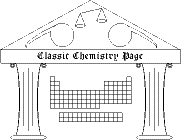Joliot-Curie artificial transmutation
Irène Joliot-Curie and Frédéric Joliot were awarded the Nobel Prize in chemistry in 1935 for the production of artificial isotopes. For example, one previously unknown isotope was the result of exposing aluminum to alpha particles. There were two sets of products observed from the reaction of an alpha particle (4He nucleus) with a nucleus of 27Al; one set includes a free proton (1H nucleus) and the other a free neutron. Using modern notation for isotopes (AX, where A is the mass number and X the element symbol) complete the equations of these two reactions. How many protons and how many neutrons were in each product nucleus?
a) 27Al + 4He -- > __ + 1H .
b) 27Al + 4He -- > __ + 1n .
(Hint: a free neutron 1n has a mass number of 1 and an atomic number of 0.)
Reference
Frédéric Joliot-Curie, "Chemical evidence of the transmutation of elements," Nobel Lecture, Dec. 12, 1935, Nobelstiftelsen Chemistry, volume 2, pp. 369-73.
Copyright 2003 by Carmen Giunta. Permission is granted to reproduce for non-commercial educational purposes.

| Back to the top of the Classic Chemistry site |